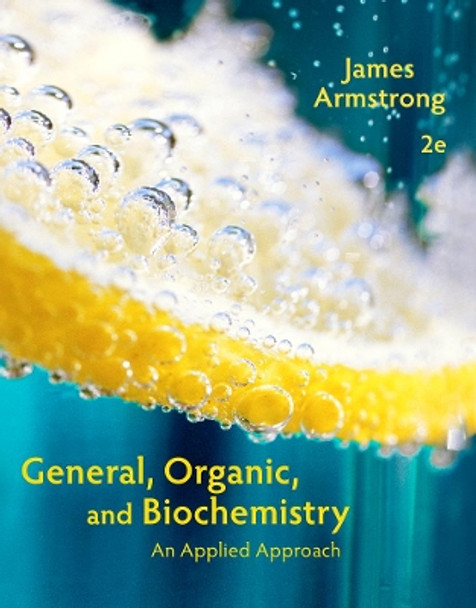Description
About the Author
Jim Armstrong attended Harvard University as an undergraduate student and then moved to the West coast for graduate school. Since earning his Master's degree at the University of California at Berkeley, Jim has taught in the California community college system. He has been on the faculty of City College of San Francisco for the past 20 years, during which time he has taught the full range of lower-division chemistry courses, with particular emphasis on the single-term GOB course. Ten years ago, he collaborated with the CCSF biology and nursing departments on an extensive revision of the GOB curriculum, and the success of the course revision led to the writing of this textbook. Besides teaching and writing, Jim enjoys playing piano and trombone, collecting topographic maps, bird watching, and doting on his wonderful twin daughters.
Reviews
1. MEASUREMENTS IN SCIENCE AND MEDICINE. 1.1 Measuring size: distance, mass, and volume. 1.2 Measurements in science: precision and accuracy. 1.3 Metric units and their relationships. 1.4 Unit conversions and conversion factors. 1.5 Using multiple conversion factors. 1.6 Density, dosage, and other compound units 1.7 Temperature. Connections: Why Do We Struggle Against the Metric System? 2. ATOMS, ELEMENTS, AND COMPOUNDS. 2.1 Classifying matter: mixtures, compounds, and elements. 2.2 Atoms and atomic structure. 2.3 Electron shells and valence electrons. 2.4 An introduction to the periodic table. 2.5 Isotopes and atomic weight. 2.6 Moles. 2.7 Compounds, chemical formulas, and moles. Connections: The Elements of Life. 3. CHEMICAL BONDS. 3.1 Covalent bonds and the octet rule. 3.2 Double and triple bonds. 3.3 Electronegativity and polar bonds. 3.4 Naming covalent compounds. 3.5 Ions and ionic compounds. 3.6 Writing formula for ionic compounds. 3.7 Naming ionic compounds. 3.8 Polyatomic ions. 3.9 Recognizing ionic and molecular compounds. Connections: Nitrogen and Oxygen: A Remarkable Partnership. 4. ENERGY AND PHYSICAL PROPERTIES. 4.1 Heat and energy. 4.2 The three states of matter. 4.3 The properties of gases. 4.4 Gas law calculations. 4.5 Attractive forces and the physical properties of matter. 4.6 Solutions and the dissolving process. 4.7 Electrolytes and dissociation. Connections: Temperature, Pressure, and Volume in Everyday Life. 5. SOLUTION CONCENTRATION. 5.1 Concentration. 5.2 Solubility. 5.3 The relationship between solubility and molecular structure. 5.4 Molarity. 5.5 Osmosis, dialysis, and tonicity. 5.6 Equivalents. 5.7 Dilution. Connections: Physiological Dehydration. 6. CHEMICAL REACTIONS. 6.1 Physical changes and chemical reactions. 6.2 Chemical equations. 6.3 Mass relationships in a chemical reaction. 6.4 Heats of reaction. 6.5 Combustion reactions and the carbon cycle. 6.6 Reaction rate and activation energy. 6.7 Chemical equilibrium. Connections: Energy from Food. 7. ACIDS AND BASES. 7.1 The self-ionization of water. 7.2 The pH scale. 7.3 Properties of acids. 7.4 Properties of bases. 7.5 Acid-base reactions. 7.6 Amphiprotic molecules and ions. 7.7 Buffers. 7.8 The role of buffers in human physiology. Connections: Consequences of Blood pH Changes. 8. NUCLEAR CHEMISTRY. 8.1 Nuclear symbols. 8.2 Writing nuclear equations. 8.3 Energy and nuclear reactions. 8.4 Measuring radiation. 8.5 Radiation sources and shielding. 8.6 Nuclear decay and half-life. 8.7 Nuclear fission and fusion. Connections: Diagnostic Imaging. 9. HYDROCARBONS: AN INTRODUCTION TO ORGANIC MOLECULES. 9.1 The special properties of carbon. 9.2 Linear alkanes: the foundation of organic chemistry. 9.3 Branched alkanes, cycloalkanes, and isomers. 9.4 Naming branched alkanes: the IUPAC system. 9.5 Functional groups. 9.6 Alkenes and alkynes. 9.7 Cis and trans isomers of alkenes. 9.8 Benzene and aromatic compounds. 9.9 Properties of hydrocarbons. Connections: High-Octane Hydrocarbons. 10. HYDRATION, DEHYDRATION, AND ALCOHOLS. 10.1 The hydration reaction. 10.2 Controlling the product: an introduction to enzymes. 10.3 Naming alcohols. 10.4 The physical properties of alcohols. 10.5 Chirality in organic molecules. 10.6 The dehydration reaction. 10.7 Phenols and thiols. Connections: Alcohols for Drinking - Or Not. 11. CARBONYL COMPOUNDS AND REDOX REACTIONS. 11.1 Hydrogenation and dehydrogenation. 11.2 Oxidation and reduction reactions and the carbonyl group. 11.3 The naming and properties of aldehydes and ketones. 11.4 Other oxidation and reduction reactions. 11.5 Carboxylic acids. 11.6 Biological oxidations and reductions: the redox coenzymes. 11.7 Introduction to metabolic pathways. Connections: Fragrances and Flavors. 12. ORGANIC ACIDS AND BASES. 12.1 Reactions of organic acids. 12.2 Decarboxylation reactions. 12.3 Amines. 12.4 Acid-base reactions of amines. 12.5 The physiological behavior of organic acids and bases. Connections: Messing With Your Mind: The Power of Tryptamines. 13. CONDENSATION AND HYDROLYSIS REACTIONS. 13.1 An introduction to condensation reactions: ethers. 13.2 Esterification, amidation, and phosphorylation. 13.3 Condensation polymers. 13.4 Hydrolysis. 13.5 The effect of pH on the products of hydrolysis. 13.6 The ATP cycle. Connections: Common Pain Relievers. 14. PROTEINS. 14.1 Amino acids. 14.2 Peptide bonds and the secondary structure of a protein. 14.3 Side chain interactions and tertiary structure. 14.4 Protein denaturation. 14.5 Enzyme structure and function. 14.6 Sources and metabolism of amino acids. Connections: Enzyme Assays in Medicine. 15. CARBOHYDRATES. 15.1 Monosaccharides. 15.2 Isomeric forms of monosaccharides: anomers and enantiomers. 15.3 Disaccharides and the glycosidic linkage. 15.4 Common disaccharides and polysaccharides. 15.5 Carbohydrate catabolism. Connections: The Importance of Blood Glucose. 16. LIPIDS AND MEMBRANES. 16.1 Fatty acids and triglycerides. 16.2 Chemical reactions of triglycerides. 16.3 Catabolism of fatty acids. 16.4 Glycerophospholipids and cell membranes. 16.5 Concentration gradients and ATP formation. Connections: Brown Adipose Tissue and Uncouplers. 17. NUCLEIC ACIDS, PROTEIN SYNTHESIS, AND HEREDITY. 17.1 Nucleotides. 17.2 Structures of nucleic acid. 17.3 DNA replication. 17.4 Transcription and RNA processing. 17.5 Translation and the genetic code. 17.6 The mechanism of protein synthesis. 17.7 Mutations and genetic disorders. Connections: The Human Genome Project and Genetic Screening. Appendix A Mathematics Supplement. Appendix B Summary of Organic Functional Groups. Appendix C Answers to Selected Problems.
Book Information
ISBN 9781285430232
Author James Armstrong
Format Hardback
Page Count 736
Imprint Brooks/Cole
Publisher Cengage Learning, Inc
Weight(grams) 1690g
Dimensions(mm) 284mm * 223mm * 33mm




